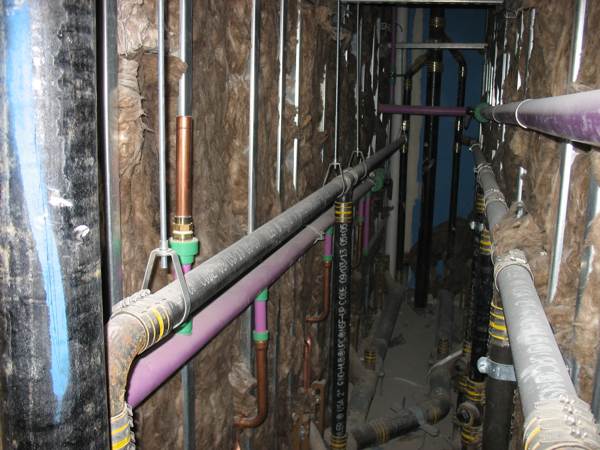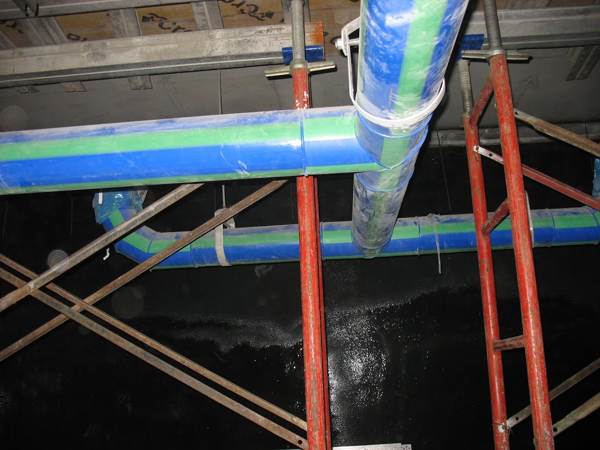UNIVERSITY OF UTAH PICKS AQUATHERM FOR INVENTIVE, SUSTAINABLE COOLING SYSTEM
Since aquatherm pipe won’t corrode, scale, wear out, or clog, and hard water doesn’t affect the piping it was the perfect pipe for the job – and less expensive than copper.
The Challenge
The engineering team designing the new building sought a corrosion-free, eco-friendly pipe system to move irrigation water from compartment to compartment in the thermal storage tank while being submerged under water.
The Solution
Since aquatherm pipe won’t corrode, scale, wear out, or clog, and hard water doesn’t affect the piping it was the perfect pipe for the job – and less expensive than copper.
 A state-of-the-art, innovative building project designed to be a first-of-its-kind LEED Platinum facility most certainly would need creative, cutting-edge solutions to various construction obstacles along the way. Such was the case for the University of Utah’s S.J. Quinney College of Law in Salt Lake City.
A state-of-the-art, innovative building project designed to be a first-of-its-kind LEED Platinum facility most certainly would need creative, cutting-edge solutions to various construction obstacles along the way. Such was the case for the University of Utah’s S.J. Quinney College of Law in Salt Lake City.
The College of Law had occupied the same campus building for 50 years, enduring a decrepit HVAC system, a lack of usable space as well as a shortage of many modern technological conveniences. The university’s administration wanted to provide a contemporary, accessible and sustainable facility—one they hope will be the first LEED Platinum law-school building in the United States—for its students, faculty, staff and guests.
After six years of intensive planning, the university began construction on a 155,000-sq-ft, six-story facility in June 2013. At the groundbreaking, S.J. Quinney College of Law Dean Robert Adler said, “This building will fulfill the educational needs of tomorrow’s lawyers while serving the broader Utah legal community and the community at large. We are committed to using the facility in ways that will better prepare skilled attorneys and problem-solving leaders.”
When it is completed in Fall 2015, the $63 million building will include large and small classrooms, a library, public reading rooms, group- and quiet-study areas, faculty and admissions offices, a café, an event catering kitchen, a student lounge and lockers, a childcare area, bicycle storage, a roof terrace and a moot courtroom with auditorium-style seating for 450 people. Also featured will be hubs in which students and faculty can analyze specific areas of law and complementary issues, such as The Center for Global Justice, The Center for Innovation in Legal Education, The Center for Law and Biomedical Sciences and The Wallace Stegner Center, which will be dedicated to examining environmental policy.
Of utmost importance to the university’s administration was the structure’s sustainable design. The administration’s goal is for all new buildings to achieve a 40% net reduction in energy costs compared to the older buildings; additionally, they intend for the new College of Law facility to save water, use safe and recycled materials and encourage environmentally responsible behavior.
net reduction in energy costs compared to the older buildings; additionally, they intend for the new College of Law facility to save water, use safe and recycled materials and encourage environmentally responsible behavior.
“There are some core attributes of the building that we’re all very proud of, one of which is sustainability,” Adler said. “We’re aspiring not only to extreme energy efficiency, but water efficiency, low-hazard materials—all of the attributes that make a building both healthy to the people living in it and healthy to the community and the globe at large.”
To that end, specific planned features include a low-water-use drip irrigation system, an onsite stormwater retention/detention system, enhanced exterior insulation to reduce thermal conductivity, exterior sun shades to reduce heat gain and regenerative elevators that convert excess energy into electricity, just to name a few.
One of the most creative sustainable components is the facility’s cooling system. Typically, a chiller is specified to create cold water for use throughout a building and provide air conditioning; however, a chiller uses about 10-15% of a building’s energy throughout the year. Considering the administration’s low-energy-use mandate, an ordinary chiller would have consumed too much of the facility’s available resources.
Instead, Phil Jankovich, designing engineer, and his team at Colvin Engineering Associates, Salt Lake City, came up with a way to use the university’s irrigation system to cool the new facility. From April through October, the irrigation system pumps water at nearly 1,000 gpm from a 450-ft-deep well located across the street from the College of Law. Jankovich and his team realized they could pump irrigation water from the campus’ main distribution line at night to use for cooling during the day if they could figure out how to store thousands of gallons of water on the new building’s first floor—a vertically small space.
“Most thermal storage tanks are 40-ft tall,” Jankovich said. “But we were limited to a 12-ft. depth for our tank.”
“The thermocline isn’t warm enough for efficient heat transfer or cold enough to cool the building,” Jankovich said. “With only a 12-foot depth to work with, one-fourth—3 feet across 375,000 gallons—of the water was unusable. That was unacceptable.”
Jankovich partitioned the tank into four compartments with eight inlets and eight outlets apiece; although water flows from compartment to compartment, each one is designed like its own complete 40-ft thermal storage tank. With this design, the 3-ft thermocline flows from one compartment to the next, existing only in one section at a time and taking up one-sixteenth of the total—a much more reasonable amount.
The full cooling system is truly cutting edge. At night, 54˚F ground water is pumped from the well into the irrigation piping. Some of the water is pumped and routed through a heat exchanger to cool the warm water in the thermal storage tank. Throughout the day, the water that was cooled overnight is delivered to the building for air conditioning; the water warms and is returned to the tank for cooling. In the thermal storage tank, the cold water flows from compartment to compartment in one direction to cool the building occupants during the day; at night, the warm water cycles in the opposite direction to cool for use the next day.
“I don’t know if there’s another system that’s even comparable,” said Rick Johansen, the university’s project manager. “This is completely new.”
SEARCHING FOR UNDERWATER CAPABILITIES

Jankovich and his team needed a unique type of piping system to move the irrigation water from compartment to compartment in the thermal storage tank; for the most part, the pipes were going to be submerged under water.
“Steel would have corroded,” Jankovich said. “Copper would have been ridiculously expensive at the large size we were using. The [university’s administration] didn’t want any PVC anywhere in the building for sustainability reasons. And HDPE was too flexible.”
Specializing in LEED-certified projects, energy modeling, computational-fluid-dynamics analysis and building-information-modeling technology such as Revit, Colvin Engineering works on all types of construction projects, from educational centers to municipal buildings to utility-distribution facilities. The firm has a history of specifying aquatherm piping systems, including other university projects such as data center applications on the campuses of Utah State University in 2007 and Brigham Young University-Idaho in 2008.
Jankovich chose to specify aquatherm polypropylene-random (PP-R) piping systems for several reasons. First, the PP-R piping won’t corrode, scale, wear out or clog—submerged or not—even after years of use; hard water doesn’t affect the piping, making it ideal for almost any application. Second, aquatherm piping systems are non-leaching and fully recyclable; they are sustainable and can contribute indirectly to LEED certification.
“Being that it was a new product on campus, there were some questions raised,” Johansen said. “But through the engineers’ guidance, we resolved any hesitation.”
Jankovich used about 730 ft of 8- and 12-in. aquatherm blue® SDR 17.6 for the thermal storage tank. Created specifically for mechanical applications, such as heating and cooling, blue allows for higher operating temperatures with thinner walls, reducing costs and improving flow rates.
In addition to the cooling application, the building project features aquatherm lilac® in ¾-, 1-, 1½- and 2-in. sizes for greywater distribution. Greywater from the sinks and showers is collected in a tank, filtered and treated onsite, and then redistributed via aquatherm lilac for the facility’s toilets.
Greywater usage is a good fit for the university because of its progressive emphasis on resource management. Ideal for greywater applications, the chemically inert lilac is a safe choice for aggressive, recycled water as it won’t affect the PP-R piping.
PUTTING THE PIECES TOGETHER
To construct the thermal storage tank, Drew Urie, general foreman for the mechanical contractor, Palmer-Christiansen Co., Salt Lake City, had to fusion weld as much of the pipe above ground as possible, then lower it into the tank.
“Two of us prefabricated about 90% of the piping in the shop, and that was a big advantage,” Urie said.
The heat-fusion process used to connect aquatherm, along with the product’s light weight compared to metal, made the operation easy.
“The contractor was able to build most of it in-house, bring it pre-built to the site and just drop it in place,” Jankovich said. “They wouldn’t have been able to attempt that with steel; it’s too large and heavy.”
aquatherm PP-R piping uses reliable heat fusion to form connections; heat fusion bonds both sides of a joint into a single, homogenous material without the use of chemicals or mechanical connections, which eliminates systematic weaknesses and fail-points in the pipe joints. The seamless heat fusion connect
ions, combined with the piping’s resistance to corrosion and abrasion, help to ease leakage concerns.
Carl Pond, CEO of Eco-Energy Systems, North Salt Lake, Utah, trained eight of the contractor’s employees on the heat-fusion process. The contractor rented Widos 4600 and 4900 butt-fusion machines for the large diameter aquatherm systems as well as McElroy hand irons for the smaller pipe.
“The contractor is now sold on it,” Jankovich said. “It’s easier to weld in comparison to steel. It’s also much easier to use—much lighter and easier to carry.”
“[Heat-fusion] is a pretty quick process,” Urie said. “But the one thing I liked about the aquatherm—probably my favorite thing—is how light it is. It’s a lot lighter than PVC and definitely lighter than steel pipe.”
Although the project is not yet complete, both Jankovich and Urie are confident in the products they specified and fabricated.
“We don’t expect any leaks through the piping,” Jankovich said.
“It’s a pretty solid project,” Urie said. “I don’t anticipate any leaks.”
With its one-of-a-kind cooling system, the College of Law won’t need to use any compressor energy for air conditioning throughout the year, helping to exceed the university’s energy-savings directive.
Interested in seeing the blooming facility? Check out the construction site’s live webcam at http://law.utah.edu/about-us/building-construction-update.
